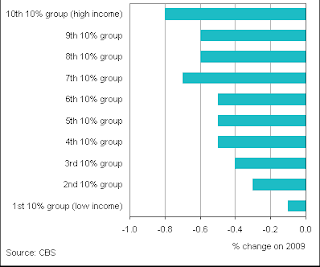The Dutch Central Bureau of Statistics reports in its latest data over 2010, the strongest decline in purchasing power since 1985: -0,5%. Here is the report:
The purchasing power of the Dutch population dropped by 0.5 percent in 2010, the most substantial decline since 1985 when Statistics Netherlands started surveying changes in the perceived purchasing power on an annual basis. The only other year to show a decline was 2005, when purchasing power dropped by 0.3 percent.
Developments purchasing power
With 1.4 percent and 0.8 percent respectively, self-employed and pensioners in particular faced loss of purchasing power in 2010.
Recipients of social security and disability benefits and employees who did not lose their jobs kept their purchasing power. Employees who lost their jobs and had to live on social security lost over 17 percent of their purchasing power.
 |
| Source: CBS |
Lowest income brackets suffer the least
The lowest income bracket lost only 0.1 percent of their purchasing power in 2010. The loss of purchasing power could run up to – 0.8 percent for the highest income earners. Self-employed and pensioners in particular lost purchasing power. Self-employed are overrepresented in the higher-income groups. Pensioners suffered as their supplementary pensions were barely indexed in 2010. The higher the supplementary income, the more this is felt.
 |
| Source: CBS |
Especially self-employed people get the lion share of this loss of purchasing power: -1.5%. These are not only shop-owners and other independent workers in the consumer market, that suffer from declining consumption. It are also free-lance workers in the building and construction industry, ICT, project management and business administration that lose their assignment or keep it, but at a much lower hourly rate.
At this moment, the phenomenon occurs that The Netherlands is still incorporating the last economic crisis (2008-2009) into its current economy, while the next crisis (in reality a follow-up on the last crisis) seems already here.
It is my expectation that the coming years the drop in purchase power might be stronger and the unemployment figures might rise substantially, due to deteriorating circumstances for:
· The civil services and government jobs, as a result of substantial government cutbacks.
· The financial industry
· The manufacturing industry.
Especially the last category will (in my opinion) suffer from the fact that the part-time unemployment benefit, which was established in 2009, prevented companies from reducing overcapacity in numbers of jobs and production facilities. As a consequence of this special government subsidy, companies kept people under contract that otherwise would have been dismissed. How noble that may seem initially, it makes companies less competitive. Especially now a new crisis is looming, due to the continuing problems in the Euro zone.
Instead of a lasting positive effect on the employment situation, the parttime UB did only have a shifting effect: postponing the inevitable loss-of-jobs to a few years later. This effect may be reinforced by the current effects of the deteriorating economy in Europe : a double-whammy.


No comments:
Post a Comment